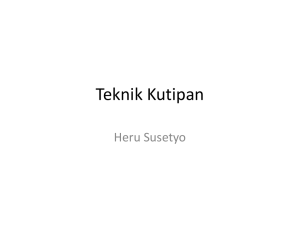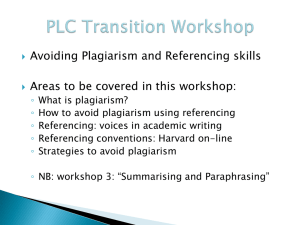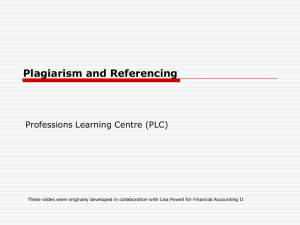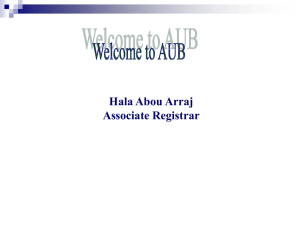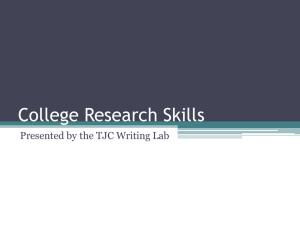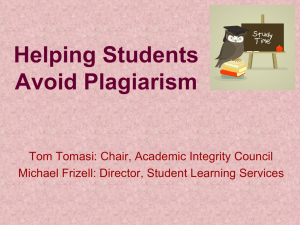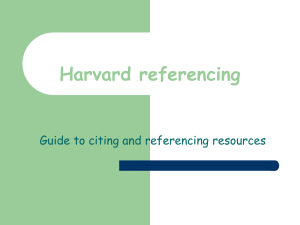Referencing correctly and avoiding plagiarism
advertisement
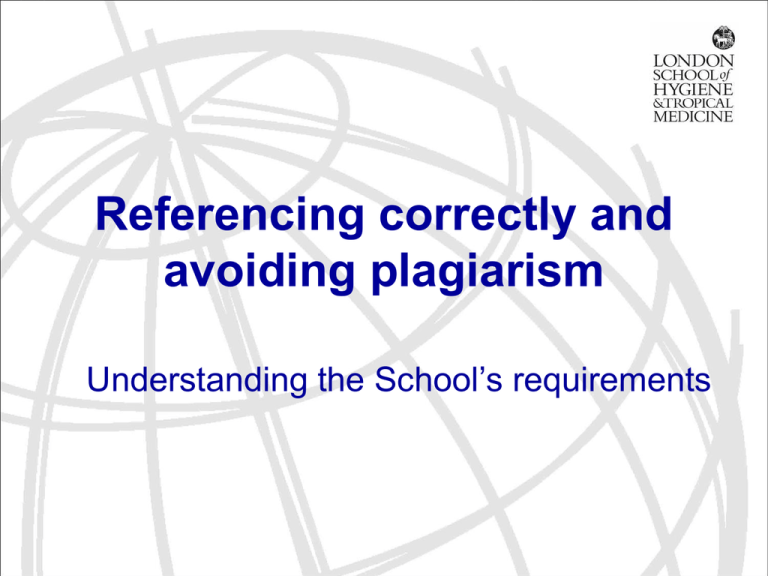
Referencing correctly and avoiding plagiarism Understanding the School’s requirements This session will cover: • Understanding references (to journal articles, books, book chapters, reports, web pages etc.) • Citing and referencing – how to do it right • Plagiarism – what it is and how to avoid it (with a worked example) • How the School detects plagiarism Further sources of information • Detailed further guidance on everything covered in this session is available in the Academic Writing handbook. • This has lots in it – but you should be able to ‘dip in’ to find any specific guidance you need. Understanding references Understanding references Journal articles Creese A et al. (2002) Cost-effectiveness of HIV/AIDS interventions in Africa: a systematic review of the evidence. The Lancet 359: 1635-1642. Understanding references Books Hahn, R. (1999) Anthropology in Public Health. Oxford, Oxford University Press. Understanding references Book chapters Collier, S.J. and A. Ong (2005). Chapter 1: Global assemblages, anthropological problems. Global Assemblages. Technology, Politics, and Ethics as Anthropological Problems. A. Ong and S.J. Collier. Oxford, Blackwell: 3-21. Understanding references Reports Statistics for Wales (2008). Health statistics Wales 2008. Welsh Assembly Government. Understanding references Web pages and online documents Centers for Disease Control and Prevention: Multidrug-Resistant Tuberculosis (MDR TB). Division of Tuberculosis Elimination, Centers for Disease Control and Prevention: Atlanta GA; April 2010 [online: accessed 27 September 2010]; www.cdc.gov/tb/publications/factsheets/drtb/m drtb.htm Exercise/examples What type of source documents do the following refer to? • National Institute for Clinical Excellence, 2001. Guidance on the use of orlistat for the treatment of obesity in adults, [online], NICE, London. Accessed 11 October 2006. www.nice.org.uk/page.aspx?a=15724 • Cook G. Manson’s tropical diseases. 21st ed. London: WB Saunders. 2003. • Bach, S. Migration patterns of physicians and nurses: still the same story? Bull World Health Organ. 2004;82(8):624-5. • Reeves, M., Rosas, L. "Nobody told me they were harmful": pesticide exposure and the health of women farm workers. In: Jacobs, M., Dinham, B., editors. Silent invaders: pesticides, livelihoods and women's health. London: Zed Books; 2003. p. 16-30. Citing and referencing – how to do it right Citing and referencing The School requires that your written work should: i. Acknowledge the work of others wherever you make use of it. ii. Present these acknowledgements in a consistent way, using a recognised citation system. iii. Include a detailed reference list at the end. Citing and referencing (i) Acknowledging the work of others • You must give a reference whenever you: quote directly from a source, paraphrase, use ideas or material from others, etc. • This includes all kinds of sources: printed materials like books or journal articles; electronic information like webpages or emails; images, graphs and tables; recorded or spoken information; etc. Citing and referencing (ii) Using a recognised citation system • Always present references in a standard style. • This determines how you write both in-text citations and the reference list at the end. • Whichever system you use should apply throughout your piece of work – do not ‘mix and match’ different referencing styles. • The two most common styles are Harvard (author/date) and Vancouver (numbering). Citing and referencing In the Harvard style, the author's surname and year of publication should be quoted in the text. e.g. • "as confirmed by Abrams (1969)" • "as confirmed by another study (Gillespie et al. 1983)” Citing and referencing In the Vancouver style, each citation should be numbered sequentially in the text, either in brackets or as a superscript. e.g. • “ as confirmed by Abrams (3) ” • “ as confirmed by another study 4 ” Citing and referencing (iii) Giving a formal reference list • Full details about everything you cite should be given in a reference list (sometimes called a bibliography) – at the end of your work. • This should give sufficient details to enable a reader to look up the original source material. • The referencing style you use will determine how the list is ordered, and the precise information you need to give. Citing and referencing • In the Harvard style, the reference list at the end should be arranged by alphabetical order of the first author's name • An example (for a journal article) would be: Ganapati R., Naik S.S., Acharekar M.Y. and Pade S.S. (1976) ‘Leprosy endemicity in Bombay: an assessment through surveys of municipal schools’, Leprosy Review 47: 127 – 31. Citing and referencing • In the Vancouver style, the reference list at the end should give references in numerical order, i.e. the order they appear in the text. • An example (for a journal article) would be: 2. Ganapati R, Naik SS, Acharekar MY and Pade SS. Leprosy endemicity in Bombay: an assessment through surveys of municipal schools. Leprosy Review 1976; 47: 127-31. Plagiarism – what it is and how to avoid it What is plagiarism? LSHTM definition: • Plagiarism is the copying or use of the work of others, whether intentionally or unintentionally, as if it were your own. Such work may come from any source whether published or unpublished, in print or online – including words, images, audio recordings, diagrams, formulae, computer code, performances, ideas, judgements, discoveries and results. What else must I avoid? In addition to plagiarism, the School defines other ‘assessment irregularities’ you must avoid. These include: • Collusion – unacknowledged collaboration with others • Personation – someone else doing ‘your’ work • Fraud – fabricating, falsifying or omitting information • Cheating – any deliberate attempt to deceive in order to gain advantage in assessments How to avoid committing plagiarism • Always acknowledge anywhere you use other people’s work (or even your own past work). • Always use a standard referencing style. • Quotations should be clearly identified (with “quote” marks), with a reference to the author(s). • Paraphrasing (using your own words to express the ideas or judgements of others) must also acknowledge the original author(s). • Where you have worked collaboratively, always note the involvement and input of others. Plagiarism: a worked example Original text: One of the most important issues that remain controversial is whether 6 months of treatment with regimens that include rifampin can effectively and safely treat HIV-related tuberculosis. (El-Sadr WM, Perlman DC, Denning E, Matts JP, Cohn DL. A review of efficacy studies of 6-month short-course therapy for tuberculosis among patients infected with human immunodeficiency virus: differences in study outcomes. Clin Infect Dis 2001;32:623-32.) Good… GOOD: direct quotation with citation Here is the original text, within quotation marks, followed by a citation to the authors. “One of the most important issues that remain controversial is whether 6 months of treatment with regimens that include rifampin can effectively and safely treat HIV-related tuberculosis” (El-Sadr et al, 2001). GOOD: paraphrasing with citation You may paraphrase the original text or idea in your own words, without quoting directly – but if so, you must always clearly cite the source. There remains debate as to whether HIV-related tuberculosis can be treated with short course regimens that include rifampin (El-Sadr et al. 2001). Bad… BAD: direct quotation without indication The following would not be acceptable, because the word-for-word quotation is not indicated by inverted commas: One of the most important issues that remain controversial is whether 6 months of treatment with regimens that include rifampin can effectively and safely treat HIV-related tuberculosis (El-Sadr et al, 2001). BAD: tiny changes to text Just changing a few words is insufficient . The following is not paraphrased in new words, just edited very slightly: One of the key issues that remains controversial is whether 6 months of treatment with regimens that include rifampin can effectively treat HIV-related TB (El-Sadr et al, 2001). Compare this to the original: One of the most important issues that remain controversial is whether 6 months of treatment with regimens that include rifampin can effectively and safely treat HIV-related tuberculosis. (El-Sadr WM, Perlman DC, Denning E, Matts JP, Cohn DL. A review of efficacy studies of 6month short-course therapy for tuberculosis among patients infected with human immunodeficiency virus: differences in study outcomes. Clin Infect Dis 2001;32:623-32.) Worse… BAD: quotation without citation Presenting a quote without inverted commas to indicate it is a quotation, and without a citation to indicate the authors, is clear plagiarism: One of the most important issues that remain controversial is whether 6 months of treatment with regimens that include rifampin can effectively and safely treat HIV-related tuberculosis. BAD: paraphrasing without citation Editing or paraphrasing someone else’s specific words or ideas, then presenting them without a citation to indicate the authors, is also plagiarism: There is debate concerning the use of short-course regimens to treat tuberculosis in people with HIV infection. Summary Good: • Identical text, with quote marks, with citation • Re-worded text, no quote marks, with citation Bad: • Identical text, no quote marks (even if a citation is given) • Tiny changes to text , no quote marks (even if a citation is given) • Identical text, no quote marks, no citation • Re-worded text, no quote marks, no citation How the School detects plagiarism LSHTM procedures • All markers are asked to be on the lookout for potential plagiarism. • The School also uses the plagiarism detection service Turnitin UK to check student work. • Rigorous (and clear and fair) procedures are in place to investigate and reach a judgement where plagiarism is suspected. Detecting plagiarism The report on the following page shows text matched by Turnitin against original sources. What do you notice? Detecting plagiarism Last tips to avoid plagiarism 1. Leave enough time to find and read the information you need 2. Use clear note taking techniques 3. Reference all your sources Take care!
